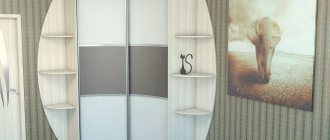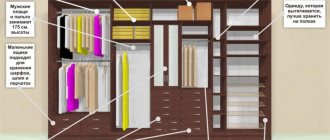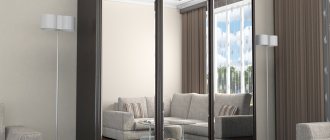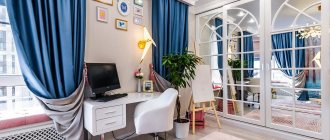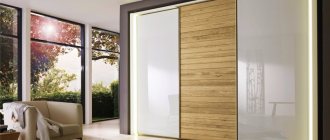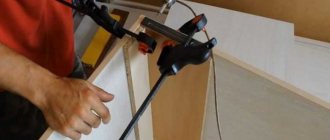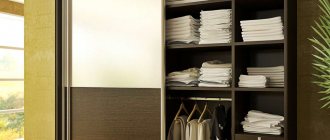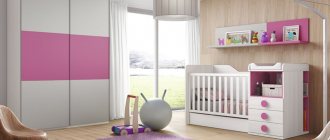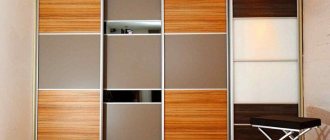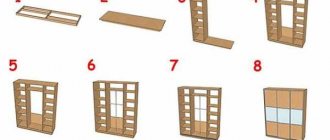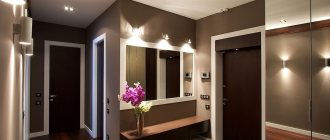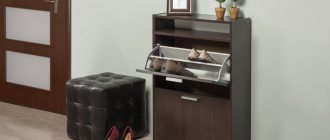Properly organized filling of a corner wardrobe will solve most of the problems of assembling things and simplify access to the most popular items. To achieve an optimal result, it is necessary to take into account a number of factors: select a suitable design; identify the important elements needed in the bedroom or hallway; you need to navigate the variety of modern devices available on the furniture market. All these points will be discussed in detail below.
The filling can be arranged according to your taste - the main thing is to plan in advance
Typical sizes of corner cabinets
The filling of a corner wardrobe directly depends on its dimensions and shape. These parameters are determined by the needs of the user, the purpose of the room and its area.
Triangular
This option is more common in spacious rooms. The lengths of the sides are the same and are never less than 1.2 m. The functionality of a structure with walls shorter than a meter is significantly reduced - some sections will have to be removed or made too small and inconvenient. One and a half meter sides, on the contrary, expand the possibilities for organizing the internal space, but take away the usable area of the room, which is why they are used less often.
The depth of the sections is 40-60 cm. The most common option is 45 cm; a maximum of 60 cm is suitable for arranging wardrobe departments. The width is selected depending on the purpose:
- compartments with shelves – up to 50 cm;
- with a hanger bar 80-90 cm;
- the outer side sections with an internal L-shaped layout are 30 cm.
L-shaped
The simplest and most popular form among users. Each wall is adjacent to a straight part, and the corner is filled with either a five-wall module with shelves, or this area is used as a compartment for storing things on hangers. Unlike triangular counterparts, L-shaped ones use the space of the room more efficiently and provide better access to the contents of the sections.
The walls of the structure can be either the same or different, with the minimum value usually about a meter, and the maximum can reach 2-2.5 m, depending on the layout. The depth is usually standard - 50-60 cm.
Examples of filling L-shaped cabinets for the hallway
Diagonal
In fact, it is a triangular cabinet with different sides. Main characteristics:
- The length of the smaller leg is from 70 cm; larger – up to 240 cm.
- Depth – 50-60 cm.
- Height – 170-250 cm.
The number of departments is determined by the larger wall. For example, with a length of 220 cm and a width of 70 cm, three compartments are made of approximately 70 cm each. If the length of the smaller leg is 1 meter or more, the outer section is adapted for shelves, and the rest of the space is left for a bar with hangers located on the larger side.
For diagonal structures, one side is always smaller than the other
Trapezoid shape
Unlike triangular analogues, here the diagonal is adjacent to the wall on one side and the side edge of the cabinet on the other. This option is considered more compact than those described above, since the space of the room is used more efficiently. The sides of the trapezoidal structures are not the same: the smaller one is about 80cm; large - at least 120 cm.
The dimensions and layout of the departments depend on the length of the walls and are practically no different from those for triangular and diagonal cabinets.
Radial
Thanks to the curved shape, they are characterized by greater capacity. The doors are made convex, follow the perimeter and move along a sector of the circle. Radius cabinets look unusual; small corner structures with equal walls resemble shower stalls. However, there are interesting design solutions that combine straight and concave shapes, which, together with the right material, gives quite impressive results.
The height of standard models is up to 2.5 m (minimum 1.8 m). The length of the rear walls, as a rule, is not less than a meter. The maximum dimensions are limited by the area of the room, its furnishings and user preferences.
The most correct, from the point of view of space saving, options are L-shaped and radius with a door concave inward. With this arrangement, there is no empty space in the middle, as in convex and triangular cabinets.
General recommendations for the internal filling of a corner wardrobe
Ready-made wardrobe systems with wall mounting allow you to make the most of the corner space of the closet, without the formation of dead zones due to partitions.
Despite this, most often the corner wardrobe inside is equipped with shelving of various designs, assembled from laminated chipboard. It is important to correctly plan the location of shelves and open niches for clothes so that the internal filling is convenient to use.
The corner wardrobe inside is made more functional and practical by various storage systems:
- Multi-level rods and pantographs for clothes on hangers.
- Drawers, mesh baskets and shoe shelves.
- Ties, trousers, hooks and other devices.
When placing retractable and roll-out storage systems, lowering furniture elevators, it is important to take into account that the corner wardrobe inside has a specific free space:
- Retractable mechanisms should be placed taking into account the width of the doorway and the free space inside. Make sure that they will not rest against the retracted facade of the compartment, but will fall into the free opening.
- The design of a corner wardrobe with internal partitions should not cause the formation of hard-to-reach places; hangers and shelves should not be overlapped by more than half with vertical racks - otherwise they will be inconvenient to use.
- It is undesirable to design openings that are too long with shelves longer than 600-700mm without additional stops; they may bend under heavy load.
- As practice shows, it is better not to make linen drawers on simple ball or roller guides wider than 600-800mm. Due to heavy loading, retractable mechanisms can quickly fail, and the fiberboard bottom can bend under the weight. Use more durable metaboxes or metal baskets for these purposes.
Before making your final decision, carefully check all dimensions, distances between shelves and partitions, and other elements of the internal design of the corner wardrobe. Even minimal defects can negatively affect ease of use.
Required components for an adult and child's bedroom
The contents in the bedroom do not have fixed standards and are selected in accordance with the user’s preferences. However, there are a number of components whose installation is considered generally accepted:
- Drawers. They usually store small items and items of clothing. For convenience, it is possible to install a finishing mechanism.
- Section for placing clothes on hangers. Usually this is the most spacious part, at least as wide as the hanger (55 cm).
- Shelves. Stationary or removable partitions are very convenient for folding laundry, things in boxes, travel bags and other items.
- Baskets. Special ventilated containers are used for linen and clothing. Items placed in the basket are easily accessible and well ventilated.
- Trousers. Pull-out or fixed holders designed for quick and convenient storage of trousers.
What's inside the triangular wardrobe in the bedroom
Filling
The internal content depends on what things the cabinet is intended for. If these are models for the hallway, then storage of seasonal items is assumed. Therefore, the standard set includes a compartment for outerwear with a hanger bar, shelves for shoes, hats, and things.
The corner built-in segments in the bedrooms have a slightly different content. These may include:
- rod or pantograph (lowering bar for hangers). Such a mechanism in cabinets can be oil or hydraulic (gas);
- hangers for various things;
- devices for storing accessories, ties, belts and so on;
- special holders for trousers;
- pull-out laundry baskets (socks, tights);
- shelves for storing seasonal items.
Manufacturers produce many different types of fittings for built-in wardrobes. Most are made of composite or chrome-plated materials. Popular are retractable wicker baskets mounted on guide rails.
There are built-in corner segments that are designed for storing household items. Then the filling will be slightly different. It is calculated based on the items that will be stored and their dimensions. This could be household appliances for the home, large household items.
Required components for the hallway
The filling of a corner cabinet in the hallway most often consists of the following components:
- Outerwear department for storing items hung on hangers.
- A section with shelves for handbags and other small items that need quick access.
- Baskets (sometimes on rails with several tiers) are a popular option for hallways.
- The shoe rack is equipped with either gratings or special fastenings.
- Drawers with or without handles.
You can also place additional hangers, space for hats, corner compartments and seats.
Sometimes in the hallway you need to plan a place for large outdoor items
Varieties
There are several types of corner structures and their classification should be taken into account before choosing a model for a room.
By shape
Taking into account the type of furniture, it can be an element of a modular system or a separate cabinet, and models of different shapes can be found, among them:
- semicircular corner cabinets with convex door surfaces;
- semicircular segment with a concave surface;
- a module, which is an element of a typesetting system, can be concave or convex. Such a cabinet has side walls to which additional elements are attached;
- g-shaped segment is a transitional element;
- built-in segment in a room along a diagonal corner.
The capacity of the cabinets depends on the shape and dimensions of the module.
The advantage of this furniture is that built-in wardrobes use the so-called “blind corner”, that is, a space that is difficult to fill with standard rectangular furniture. Another advantage of the built-in corner segment is that the rounded elements are considered the most ergonomic, that is, they free up the most space in the room. The radial corner segment fits organically into different stylistic solutions; photos of similar elements are presented below.
Diagonal
Semicircular concave
Semicircular convex
With additional elements
According to manufacturing materials
A distinctive feature of the corner built-in segments is that they are attached directly to the wall. This, on the one hand, ensures a perfect fit of the furniture, on the other hand, it saves material.
What are cabinets made of:
- MDF panels are a wood board made from tiny wood chips, vacuum-pressed. There may be relief patterns on its surface. At its core, it is also a tree, but it has gone through a process of technological processing. MDF panels are covered with a special film on top or painted. The advantage of the material is durability, affordable price, wide range of colors. Painted facades can be given any color or shade, and MDF panels can also be bent at the desired angle;
- Composite materials, which consist of several components, have come into fashion. Their production is based on polymerizing resins, which can be given any shape. The angular surface of the facade made from these materials is lightweight. The load on the sliding system is reduced. The variety of colors, textures and types is impressive. Such furniture looks especially impressive in a room with a minimalist style. A semicircular wardrobe with composite doors looks stylish and literally transforms the space of the room;
- mirror and glass surfaces. They can only bend at a certain angle. For production, tempered glass is used, which does not break. The material is quite heavy, so it is divided into segments. They are inserted into an aluminum profile. Glass products are quite expensive;
- radius sliding systems made of wood are rare. They are labor-intensive to manufacture and expensive.
The built-in sliding surface of the cabinet is mounted in an aluminum profile so that it can be inserted into the sliding system guides. They come in two types: top-support and bottom-support, that is, guide rails can be attached from above or below. Most furniture makers prefer the lower support system; it distributes the load better, and the doors slide apart almost silently.
Mirror
Wood
Chipboard
MDF
Shelves
Regardless of the location of the cabinet, it must have at least one compartment with shelves. It is convenient to put clothes, bedding and other small items in it. The location can be any: in the middle on the right or on the left - depending on the project and user preferences.
The distance between the shelves is determined by the items that are supposed to be stored on them:
- Under large boxes, pillows or blankets, leave a gap of 40-50 cm.
- For clothes, 35-40 cm will be enough. This is not convenient for everyone, because if you completely fill such a shelf with things and then pull something out from below, the whole order will be disrupted. Therefore, many prefer a distance of about 25 cm.
- The mezzanine sections are the most voluminous - 40-60 cm. If they are not divided horizontally, even such large items as travel bags or suitcases will fit there.
Expert opinion
Bashir Rabadanov
Technologist at the furniture company Woodband
The depth is determined depending on the size of the cabinet. The most convenient option is 50 cm; shelves smaller than 45 cm are rare, mainly in individual projects. The depth of 60 cm will be inconvenient if you need to get something folded near the far wall.
Features and Benefits
The dimensions of corner cabinets are quite impressive, but they are usually considered compact models. This is due to the fact that they occupy only one corner of the room, and therefore do not clutter it up and fully cope with their intended purpose.
Today, the market offers consumers a variety of sizes, based on the square footage of the room.
The space of such cabinets is arranged taking into account the preferences of users. There are no sharp corners, and inside you can place a huge number of things and leave space for other needs. This is quite important when located in a nursery.
Along with this, other advantages can be highlighted: the ability to improve the aesthetic perception of the interior, visually lengthen the room and make it as comfortable as possible.
Boxes
Installed as one block consisting of two or more elements. It is not advisable to store massive objects in them; for example, you should not completely fill them with bed linen. Firstly, excessive load on the guides will lead to their premature failure. Secondly, the bottom of the box will quickly sag, since it is made of thin material (usually fiberboard, MDF), reinforced with chipboard slats.
Do not place the pull-out unit too low or on top of the cabinet. The optimal height is 90-120 cm from the floor. If the box is higher than 170 cm, it will be inconvenient to use. Standard sizes:
- width - 50 cm;
- height – 20 cm;
- depth – 45 cm.
Otherwise, the dimensions of the box depend on the compartment in which they will be located.
When making a custom cabinet, the drawers are usually built-in without an additional casing
Where can I embed
In fact, built-in furniture can be mounted to any wall or corner. Nowadays, many houses are built using a monolithic frame method, which is why non-standard corners and all sorts of niches appear in the rooms. Standard models are difficult to install in such places. For built-in furniture, these problems can be overcome. It is modeled according to individual sizes and adjusted to fit the walls. A closet, for example, in a semicircle, smooths out such problem areas. A selection of photo modules for monoliths clearly demonstrates all the advantages of corner furniture. In addition, this kind of furniture is functional; it is calculated based on the needs and dimensions of the stored items.
For small rooms with limited space, installing a semicircular segment is sometimes the only possible and rational option. For example, it could be a small hallway where there is no wall to install a standard-sized wardrobe.
Hangers
The most spacious department, designed to store things in their most natural state - on hangers. They are located on a special crossbar, which is mounted at a height of 140-180 cm from the floor. The minimum transverse size of the section should not be less than 60 cm (preferably 70-80 cm).
If the compartment is wide enough, it is possible to install several rods perpendicular to the doors, but the convenience of such an arrangement is questionable - things located near the wall are invisible and difficult to access. On the other hand, it becomes possible to sort: dresses on one bar, outerwear on another. The most convenient, but quite expensive option is retractable mechanisms located perpendicularly.
The minimum length of a standard crossbar is 50 cm. However, the dimensions of corner structures usually allow enough space to be allocated for a full meter section. The most common size is 100-120 cm.
Shoe racks
Nets or shoe racks are installed at an angle in the lower part of the wardrobe located in the hallway. Storing shoes in the bedroom is quite rare, but it is also possible, for example, if they are out-of-season models. The optimal location is considered to be under the main bar with hangers.
Another option for shelves for shoes is special designs with a front part and an internal shelf. When closed, the shoe rack looks like a drawer, and access to the contents is provided by a rotating mechanism.
Wide pull-out shoe shelf built into the closet
Built-in L-shaped corner wardrobe in a bedroom measuring 1800x1800
L-shaped corner cabinets will fit best in a bedroom, children's and teenage room with an elongated shape. In terms of internal content and general ergonomics, they are comparable to good dressing rooms.
To make the corner wardrobe functional inside and with good accessibility, it is better to place rods under hangers in the far corner.
Design the remaining number of shelves, drawers and other storage systems according to your desire for functionality.
Trousers
Designed for quick and convenient placement of more than one pair of trousers at a time. The hanger mount is compact and easily retractable. The optimal height is 120-140 cm from the floor. The width depends on the size of the section and usually does not exceed 70 cm, which allows you to place from 10 to 15 trousers, depending on the specific model. The minimum required depth of the cabinet is 60 cm. The height of the trouser rack is about 5 cm, and the space required for things placed on it is about 70 cm.
Metal trouser
In factory models, more than one trouser is not installed; when making to order, everything depends on the preferences of the future user.
Mezzanines or pantographs
Mezzanines are located at the very top and are not easy to reach without a chair or stepladder. This part is convenient for storing out-of-season clothes, blankets, pillows and other things that do not need quick access. Installing a mezzanine is not necessary, but without them, the unused space between the ceiling and the top of the cabinet will remain useless.
A pantograph is a kind of elevator to simplify access to the upper sections, which can be filled with shelves, rods or baskets. This is a worthy alternative to mezzanines; with its help you can implement modern, easy-to-use designs. However, such solutions are expensive, and cheap analogues do not last long.
